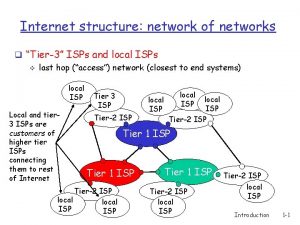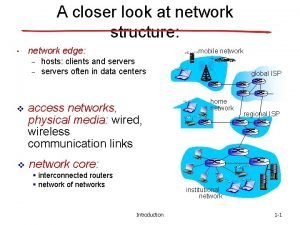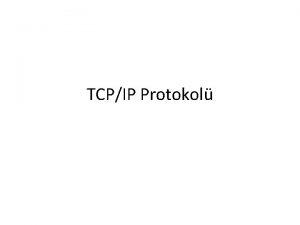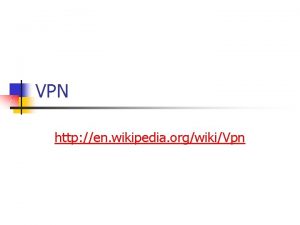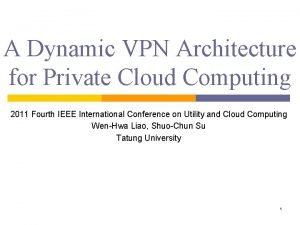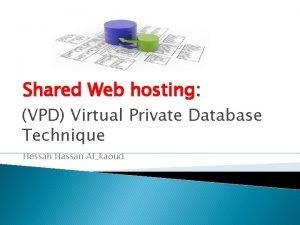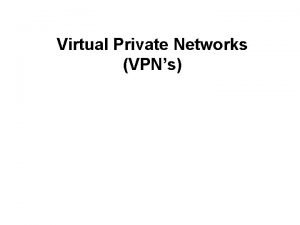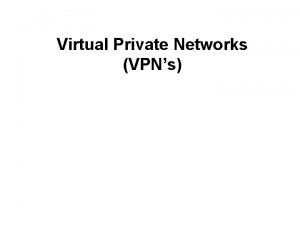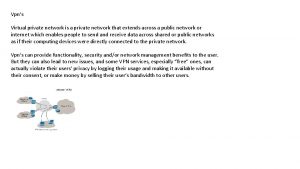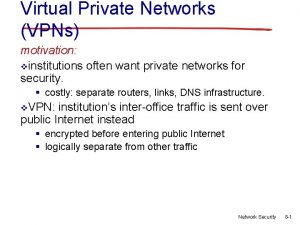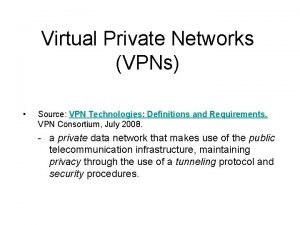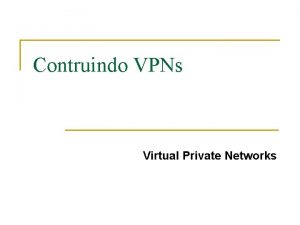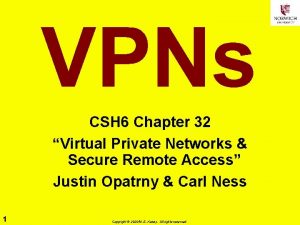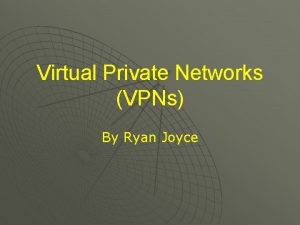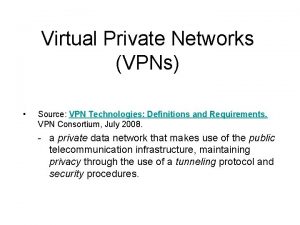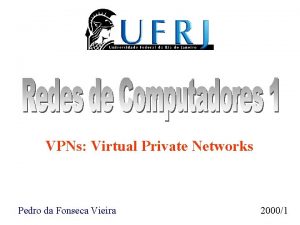VPNs Virtual Private Networks Use the Internet for












- Slides: 12

VPNs • Virtual Private Networks – Use the Internet for transmission instead of a PSDN – Sometimes called VPNs if use Frame Relay or ATM with added security Internet

VPNs • Why use the Internet? – Inexpensive – Business partners are already connected to the same network (the Internet) • May use different PSDNs, but everybody is connected to the Internet

VPNs • Problems with the Internet – Congestion: slows transmissions – Reliability: cannot always connect, sometimes fails during transmissions – Lack of security

VPNs • IETF developing IPsec security standards – IP security – At the internet layer – Protects all messages at the transport and application layers E-Mail, WWW, Database, etc. TCP UDP IPsec

VPNs • IPsec Transport Mode – End-to-end security for hosts Local Network Secure Communication Internet Local Network

VPNs • IPsec Tunnel Mode – IPsec server at each site – Secure communication between sites Local Network Secure Communication Internet Local Network IPsec Server

VPNs • IPsec Modes Can be Combined – End-to-end transport mode connection – Within site-to-site tunnel connection Local Network Tunnel Mode Internet Local Network Transport Mode

VPNs • Another Security System for VPNs is the Point-to-Point Tunneling Protocol (PPTP) – For dial-up connections, based on PPP – Connects user with securely to a remote access server at a site Dial-Up Connection PPTP Connection Internet Local Network Remote Access Server

Virtual Private Networks • Other Problems Remain • Internet Congestion is Still a Problem – Internet throughput tends to be low • Internet Reliability is Low – Cannot get connections – Backbone fails occasionally

Virtual Private Networks • Alternative – Avoid the congested and unreliable backbone! – Use one ISP that serves all sites – Should offer Qo. S service level agreement (SLAs) for latency and reliability Site 1 ISP Site 2

Virtual Private Networks • Alternative – Avoid the congested backbone – Use ISPs that “peer” with one another: connect with one another not through the Internet backbone – May offer end-to-end SLAs Site 1 ISP A ISP B Peering Site 2

WANs in Perspective • Both Leased Line Networks and PSDNs are widely used and will be for several years to come • Leased Line Networking is shrinking while PSDN networking is growing rapidly • VPN technology and standards are still immature and use will be very low for several years to come
 Difference between datagram and virtual circuit network
Difference between datagram and virtual circuit network Backbone networks in computer networks
Backbone networks in computer networks Net marketplace vs private industrial network
Net marketplace vs private industrial network Internet transport protocol in computer networks
Internet transport protocol in computer networks Tier 3 isp
Tier 3 isp Internet structure network of networks
Internet structure network of networks Computer networks and internets with internet applications
Computer networks and internets with internet applications The internet is a combination of networks glued together by
The internet is a combination of networks glued together by Interconnected networks internet
Interconnected networks internet Vpn protocols wiki
Vpn protocols wiki Virtual private network
Virtual private network Virtual private database
Virtual private database Has virtual functions and accessible non-virtual destructor
Has virtual functions and accessible non-virtual destructor




